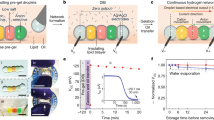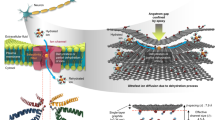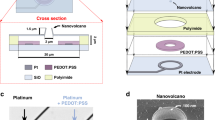Abstract
Cell membranes contain numerous nanoscale conductors in the form of ion channels and ion pumps1,2,3,4 that work together to form ion concentration gradients across the membrane to trigger the release of an action potential1,5. It seems natural to ask if artificial cells can be built to use ion transport as effectively as natural cells. Here we report a mathematical calculation of the conversion of ion concentration gradients into action potentials across different nanoscale conductors in a model electrogenic cell (electrocyte) of an electric eel. Using the parameters extracted from the numerical model, we designed an artificial cell based on an optimized selection of conductors. The resulting cell is similar to the electrocyte but has higher power output density and greater energy conversion efficiency. We suggest methods for producing these artificial cells that could potentially be used to power medical implants and other tiny devices.
This is a preview of subscription content, access via your institution
Access options
Subscribe to this journal
Receive 12 print issues and online access
$259.00 per year
only $21.58 per issue
Buy this article
- Purchase on Springer Link
- Instant access to full article PDF
Prices may be subject to local taxes which are calculated during checkout




Similar content being viewed by others
References
Hodgkin, A. & Huxley, A. A quantitative description of membrane current and its application to conduction and excitation in nerve. J. Physiol. 117, 500–544 (1952).
Altamirano, M. Electrical properties of the innervated membrane of the electroplax of electric eel. J. Cell. Physiol. 46, 249–277 (1955).
Mermelstein, C., Costa, M. & Neto, V. The cytoskeleton of the electric tissue of Electrophorus electricus, L.*. Ann. Acad. Bras. Cienc. 72, 341–351 (2000).
Rosenberg, R. L., Tomiko, S. A. & Agnew, W. S. Single-channel properties of the reconstituted voltage-regulated Na channel isolated from the electroplax of Electrophorus electricus. Proc. Natl Acad. Sci. USA 81, 5594–5598 (1984).
Keynes, R. & Ferreira, H. Membrane potentials in the electroplates of the electric eel. J. Physiol. 119, 315–351 (1953).
Gotter, A., Kaetzel, M. & Dedman, J. Electrophorus electricus as a model system for the study of membrane excitability. Comp. Biochem. Physiol. 119A, 225–241 (1998).
Thornhill, W. B. et al. Molecular cloning and expression of a Kv1.1-like potassium channel from the electric organ of Electrophorus electricus. J. Membr. Biol. 196, 1–8 (2003).
Hille, B. Ion Channels of Excitable Membranes 3rd edn (Sinauer Associates, Sunderland, MA, 2001).
Tanford, C. Equilibrium state of ATP-driven ion pumps in relation to physiological ion concentration gradients. J. Gen. Physiol. 77, 223–229 (1981).
Ussing, H. H. The frog skin potential. J. Gen. Physiol. 43, 135–147 (1960).
Novotny, J. & Jakobsson, E. Computational studies of ion-water flux coupling in the airway epithelium. I. Construction of model. Am. J. Physiol. 270, C1751–C1763 (1996).
Shenkel, S. & Bezanilla, F. Patch recordings from the electrocytes of electrophorus. Na channel gating currents. J. Gen. Physiol. 98, 465–478 (1991).
Shenkel, S. & Sigworth, F. Patch recordings from the electrocytes of Electrophorus electricus: Na Currents and PNa/PK variability. J. Gen. Physiol. 97, 1013–1041 (1991).
Dilger, J. P., McLaughlin, S. G., McIntosh, T. J. & Simon, S. A. The dielectric constant of phospholipid bilayers and the permeability of membranes to ions. Science 206, 1196–1198 (1979).
Cox, R. T., Coates, C. W. & Brown, M. V. Electric tissue—relations between the structure, electrical characteristics, and chemical processes of electric tissue. J. Gen. Physiol. 28, 187–212 (1945).
Nachmansohn, D., Cox, R. T., Coates, C. W. & Machado, A. L. Action potential and enzyme activity in the electric organ of Electrophorus electricus. ii. Phosphocreatine as energy source of the action potential. J. Neurophysiol. 6, 383–396 (1943).
Berg, J., Tymoczko, J. & Stryer, L. Biochemistry (W. H. Freeman and Company, New York, 2001).
Conti, F., Hille, B., Neumcke, B., Nonner, W. & Stampfli, R. Measurement of the conductance of the sodium channel from current fluctuations at the node of Ranvier. J. Physiol. 262, 699–727 (1976).
Humayun, M. et al. Visual perception in a blind subject with a chronic microelectronic retinal prosthesis. Vision Res. 43, 2573–2581 (2002).
Yrach, G. et al. Light-driven production of ATP catalysed by FoF1-ATP synthase in an artificial photosynthetic membrane. Nature 392, 479–482 (1998).
Drew, B. & Leeuwenburgh, C. Method for measuring ATP production in isolated mitochondria: ATP production in brain and liver mitochondria of Fischer-344 rats with age and caloric restriction. Am. J. Physiol.: Regul. Integr. Comp. Physiol. 285, R1259–R1267 (2005).
Maloney, P. C., Kashket, E. R. & Wilson, T. H. A protonmotive force drives ATP synthesis in bacteria. Proc. Natl Acad. Sci. USA 71, 3896–3900 (1974).
Romer, W. & Steinem, C. Impedance analysis and single-channel recordings on nano-black lipid membranes based on porous alumina. Biophys. J. 86, 955–965 (2004).
Brinker, J., Lu, Y., Sellinger, A. & Fan, H. Evaporation-induced self-assembly: nanostructures made easy. Adv. Mater. 11, 579–585 (1999).
Hanke, W. & Schlue, W. Planar Lipid Bilayers: Methods and Applications (Academic Press, San Diego, 1993).
Recio-Pinto, E., Duch, D., Levinson, S. & Urban, B. W. Purified and unpurified sodium channels from eel electroplax in planar lipid bilayers. J. Gen. Physiol. 90, 375–395 (1987).
Jiang, Y.-B. et al. Sub-10 nm thick microporous membranes made by plasma-defined atomic layer deposition of a bridged silsesquioxane precursor. J. Am. Chem. Soc. 129, 15446–15447 (2007).
Liu, N., Assink, R. A. & Brinker, C. J. Synthesis and characterization of highly ordered mesoporous thin films with –COOH terminated pore surfaces. Chem. Commun. 370–371 (2003).
Merzlyak, P. G., Capistrano, M. F. P., Valeva, A., Kasianowicz, J. J. & Krasilnikov, O. V. Conductance and ion selectivity of a mesoscopic protein nanopore probed with cysteine scanning mutagenesis. Biophys. J. 89, 3059–3070 (2005).
Matile, S., Som, A. & Sord, N. Recent synthetic ion channels and pores. Tetrahedron 60, 6405–6435 (2004).
Acknowledgements
We thank F. Sigworth, E. Jakobsson, S. Natarajan, J. Novotny, T.P. Ma and S. Yulke for their discussions and comments. The full description of the procedures used in this paper requires the identification of certain software and operating systems and their suppliers. The inclusion of such information should in no way be construed as indicating that such software or operating systems are endorsed by NIST or are recommended by NIST or that it is necessarily the best software or operating system for the purposes described. This work is supported by the National Centre for Design of Biomimetic Nanoconductors, funded by grant no. PHS 2 PN2 EY016570B from the National Institutes of Health through the NIH Roadmap for Medical Research.
Author information
Authors and Affiliations
Contributions
J.X. and D.A.L. conceived and designed the experiments. J.X. performed the experiments. J.X. and D.A.L. analysed the data and co-wrote the paper.
Corresponding author
Supplementary information
Rights and permissions
About this article
Cite this article
Xu, J., Lavan, D. Designing artificial cells to harness the biological ion concentration gradient. Nature Nanotech 3, 666–670 (2008). https://doi.org/10.1038/nnano.2008.274
Received:
Accepted:
Published:
Issue Date:
DOI: https://doi.org/10.1038/nnano.2008.274
This article is cited by
-
A microscale soft ionic power source modulates neuronal network activity
Nature (2023)
-
The diversity and evolution of electric organs in Neotropical knifefishes
EvoDevo (2022)
-
Quantum essence of particle superfluidity
Nano Research (2022)
-
Nanofluidics for osmotic energy conversion
Nature Reviews Materials (2021)
-
The macroscopic quantum state of ion channels: A carrier of neural information
Science China Materials (2021)



